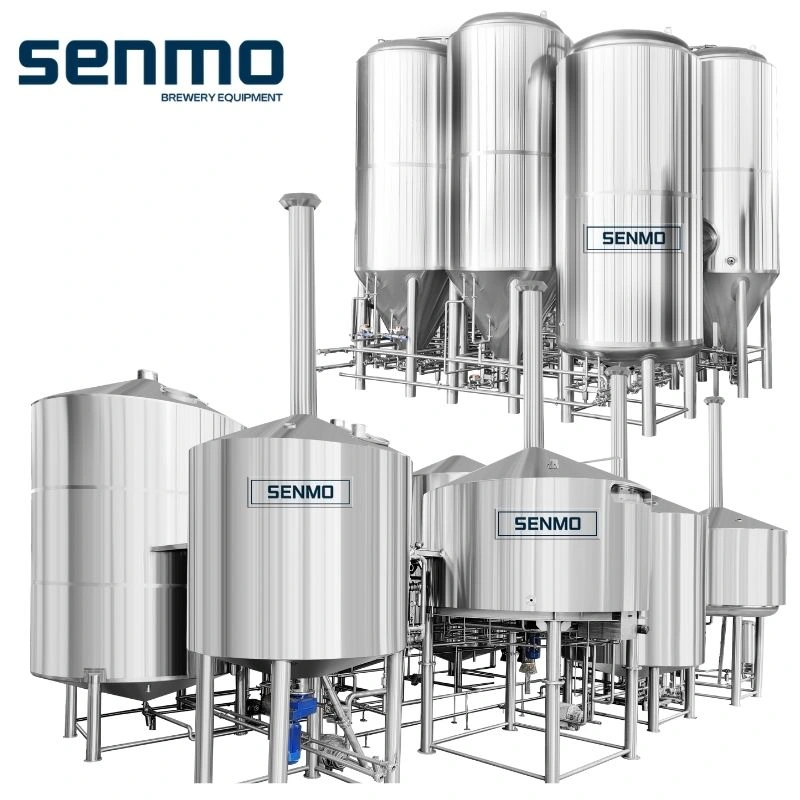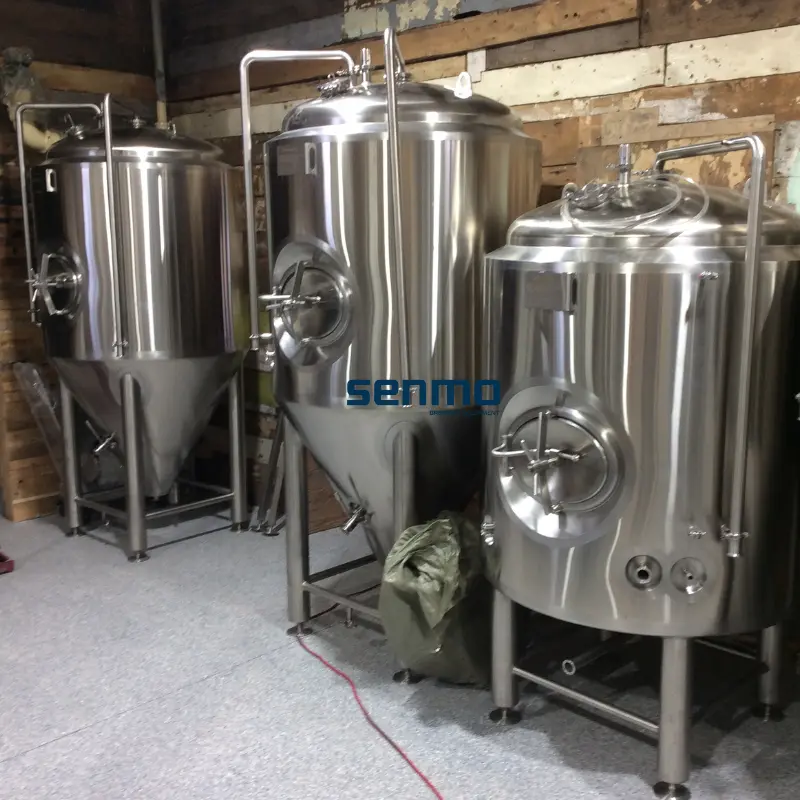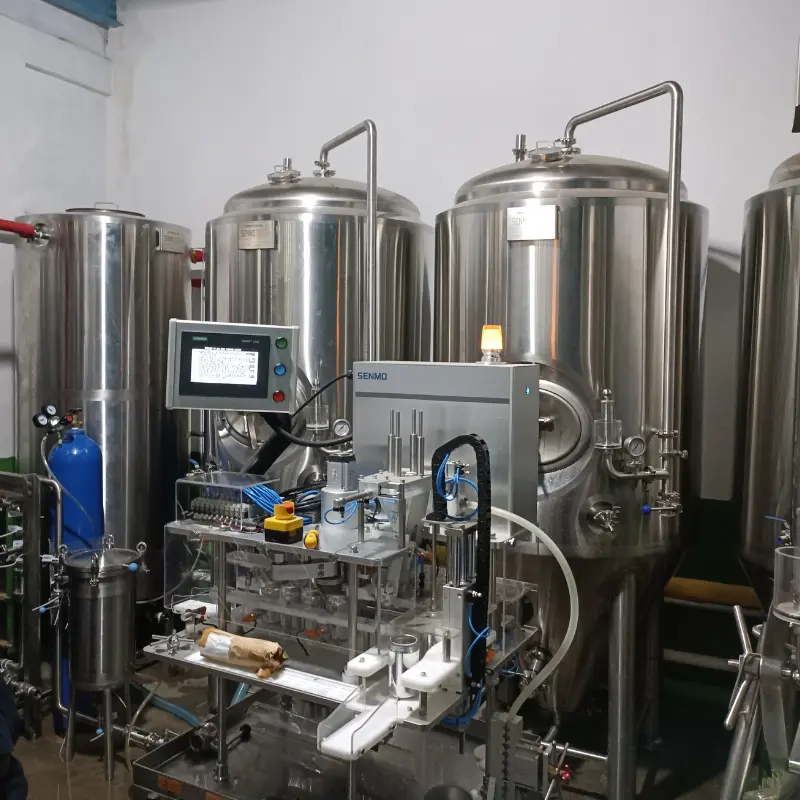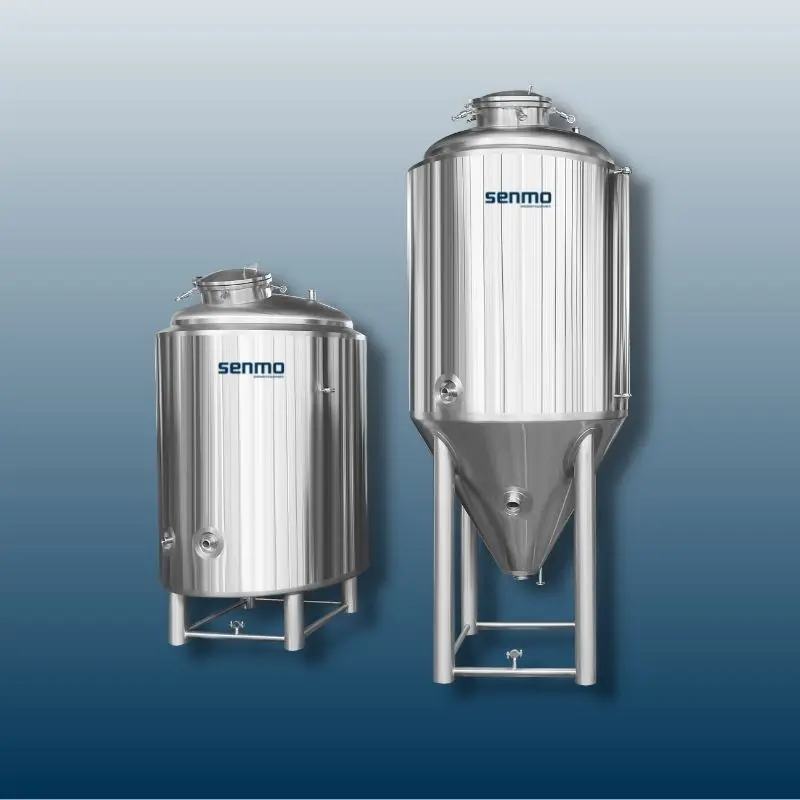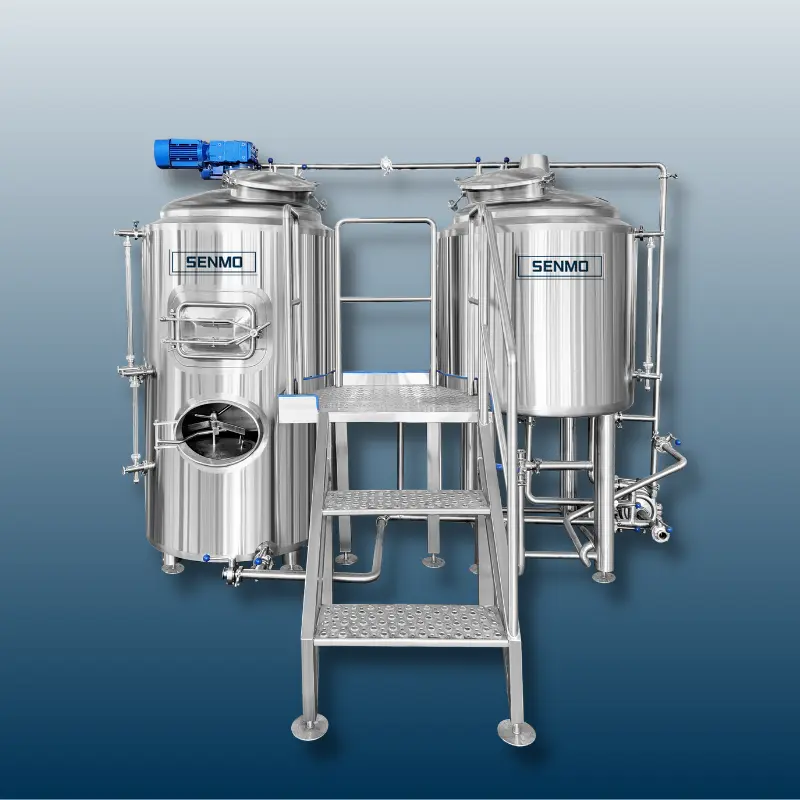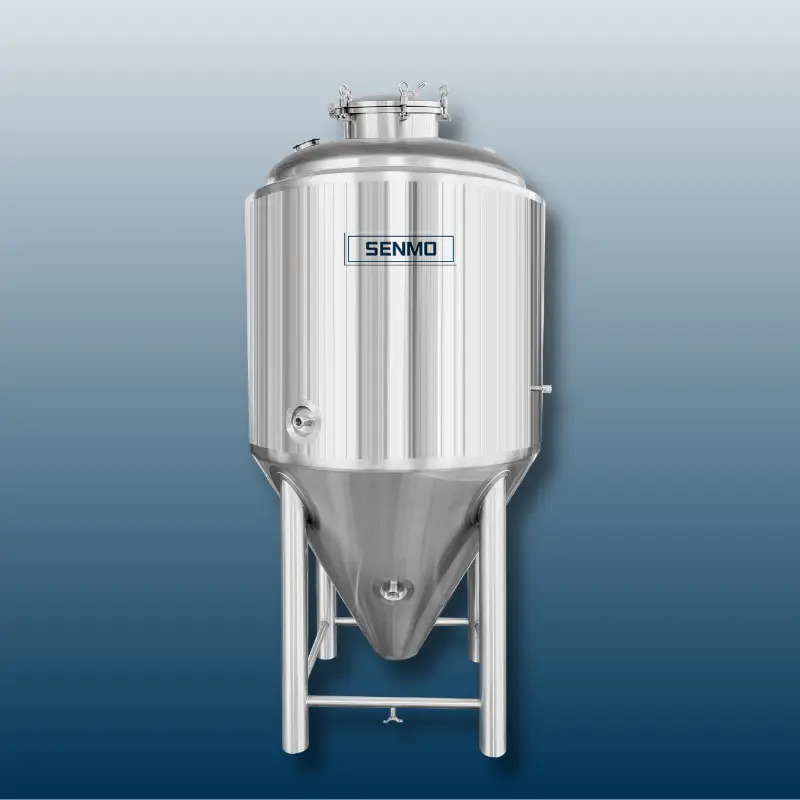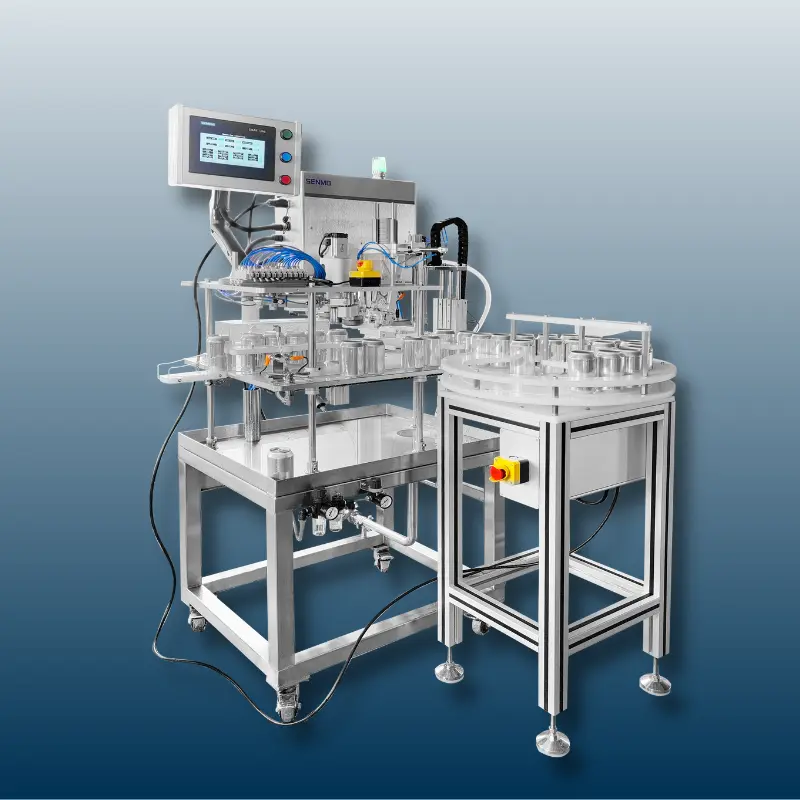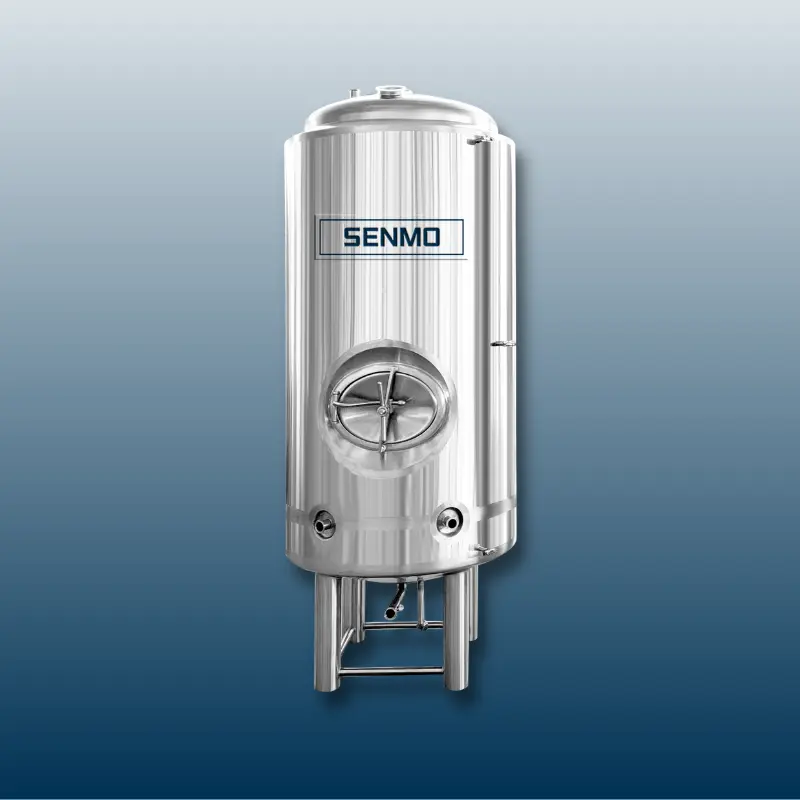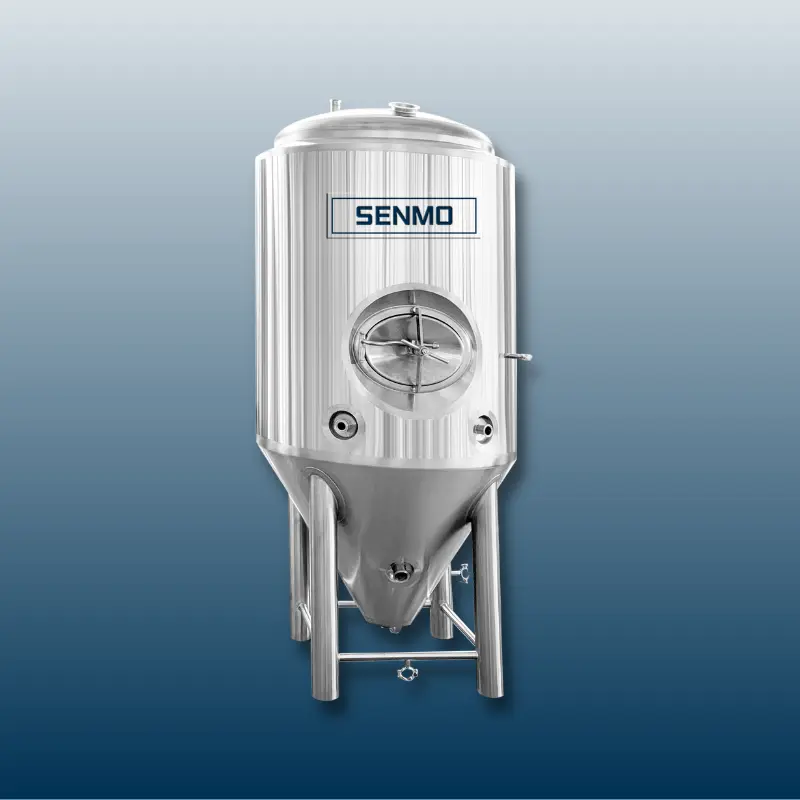Microbrewery equipment list
Microbrewery equipment encompasses a range of specialized machinery and tools tailored for small-scale beer production.
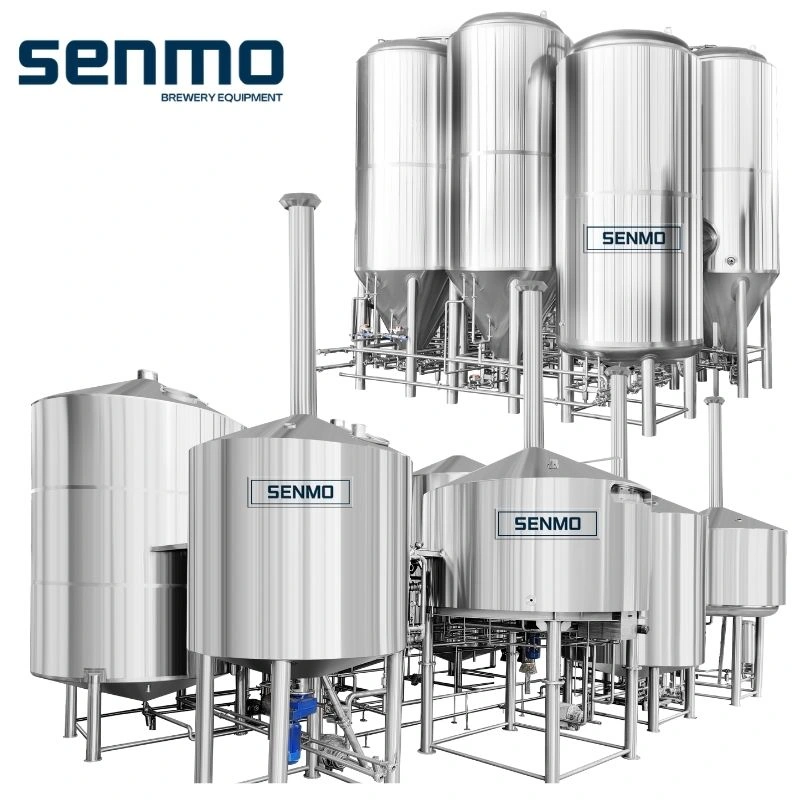
Here are some essential components:
Brewhouse Equipment:
Brewhouse Equipment plays a crucial role in the beer production process within a microbrewery. Each component serves a specific function in transforming raw ingredients into wort, the liquid extracted from malted barley, which is then fermented to produce beer. Here's a breakdown of the roles of the key brewhouse components:
Mash Tun:
Function: The Mash Tun is where milled malt is combined with hot water in a process known as mashing. During mashing, enzymes in the malt convert starches into sugars, creating a sugary liquid called wort. The Mash Tun provides an optimal environment for this enzymatic activity.
Lauter Tun:
Function: After mashing, the mixture in the Mash Tun is transferred to the Lauter Tun. Here, the liquid wort is separated from the solid remains of the malt, a process called lautering. This is achieved by draining the wort through a false bottom or screens, allowing the sugary liquid to be collected while leaving behind the grain bed.
Boil Kettle:
Function: The Boil Kettle is where the wort undergoes a vigorous boil. This serves several critical purposes:
Sterilization: The boiling process sterilizes the wort, eliminating any potential contaminants.
Flavor and Bitterness: Hops are added during the boil, imparting flavor, aroma, and bitterness to the beer.
Evaporation: Boiling concentrates the wort, enhancing its flavor and color.
Whirlpool:
Function: After boiling, the wort is transferred to the Whirlpool. This vessel creates a centrifugal force by rapidly circulating the wort, causing solids and hop residue to settle in the center. This clarifies the wort and separates it from unwanted debris before it is transferred to fermentation tanks.
The Brewhouse Equipment, consisting of the Mash Tun, Lauter Tun, Boil Kettle, and Whirlpool, collectively facilitates the initial stages of beer production. From mashing to boiling and clarifying the wort, each component contributes to the creation of a high-quality liquid base that is ready for fermentation. The effectiveness of these components is instrumental in determining the flavor, aroma, and overall quality of the final beer product.
Fermentation Equipment:
Fermentation Equipment plays a pivotal role in the beer production process within a microbrewery. These specialized vessels and systems facilitate the transformation of wort, which is the sugary liquid extracted during mashing and boiling, into beer through the action of yeast. Here's a breakdown of the roles of key fermentation components:
Fermentation Tanks:
Function: Fermentation tanks are where the primary fermentation process takes place. After the wort is boiled, it is transferred to these tanks. Yeast, which is introduced into the wort, consumes the sugars and converts them into alcohol and carbon dioxide. Additionally, the yeast imparts various flavors and aromas to the beer.
Brite Tanks:
Function: Brite tanks, also known as conditioning tanks, serve as a vessel for secondary processes after the primary fermentation. They allow the beer to undergo maturation, carbonation (either naturally or through force carbonation), and final clarification. Brite tanks also provide a platform for final adjustments before packaging.
Yeast Propagation Systems:
Function: Yeast propagation systems are specialized equipment used to cultivate and multiply yeast cultures. This is crucial for maintaining a healthy and consistent yeast population for fermentation. By providing optimal conditions for yeast growth, propagation systems ensure that a sufficient quantity of yeast is available for each batch of beer.
Fermentation Equipment, consisting of Fermentation Tanks, Brite Tanks, and Yeast Propagation Systems, plays a vital role in the latter stages of beer production. From the primary fermentation process in dedicated tanks to the conditioning and maturation in brite tanks, these components are instrumental in shaping the flavor, aroma, and quality of the final beer product. Additionally, yeast propagation systems ensure a reliable and robust supply of yeast for consistent fermentation across batches.
Cooling and Temperature Control:
Cooling and Temperature Control equipment is essential in a microbrewery for maintaining precise and consistent temperatures throughout various stages of the brewing process. These components play a critical role in ensuring the quality and characteristics of the final beer product. Here's an explanation of their functions:
Glycol Chiller:
Function: A glycol chiller is a refrigeration system that uses a mixture of water and glycol to cool the liquid that circulates through the jacket of fermentation tanks, brite tanks, and other vessels. This process is crucial for controlling the fermentation temperature, ensuring that it remains within the optimal range for the yeast strain being used.
Heat Exchanger:
Function: Heat exchangers are used to rapidly cool down the hot wort after it has been boiled. The hot wort flows through one side of the heat exchanger, while cold water or glycol runs through the other side. This allows for efficient cooling of the wort before it is transferred to the fermentation tanks.
Temperature Controllers:
Function: Temperature controllers are electronic devices that regulate the temperature of various brewing vessels, such as fermenters and conditioning tanks. They monitor the temperature and activate the glycol chiller or other cooling systems as needed to maintain the desired temperature range. Additionally, some advanced controllers allow for precise control of temperature profiles during fermentation.
Cooling and Temperature Control equipment in a microbrewery ensures that the brewing process remains within specified temperature ranges critical for yeast activity, flavor development, and overall beer quality. The glycol chiller, heat exchanger, and temperature controllers work in tandem to achieve and maintain these precise temperatures, contributing significantly to the consistency and excellence of the final beer product.
Cleaning and Sanitization:
Cleaning and Sanitization equipment and procedures are paramount in maintaining a sterile and safe brewing environment. They play a critical role in preventing contamination and ensuring the quality and safety of the final beer product. Here's an explanation of their functions:
CIP (Clean-in-Place) Systems:
Function: CIP systems are automated cleaning systems designed to clean and sanitize various brewery vessels and pipelines without the need for disassembly. They use a combination of high-pressure water, cleaning agents, and sanitizing solutions to remove residue, microorganisms, and other contaminants from equipment surfaces. CIP systems ensure thorough and consistent cleaning, promoting a hygienic brewing environment.
Cleaning Chemicals:
Function: Cleaning chemicals are specially formulated solutions used in the cleaning process. They are chosen for their ability to dissolve organic and inorganic deposits, as well as to kill or inhibit the growth of microorganisms. These chemicals include alkaline cleaners for removing protein and organic soils, acid cleaners for mineral deposits, and sanitizers to eliminate bacteria and fungi.
Brushes and Tools for Manual Cleaning:
Function: While automated CIP systems are effective for cleaning closed systems, manual cleaning tools play a crucial role in reaching areas that may be harder to access. Brushes, scrubbers, and other tools are used to physically remove stubborn residues and contaminants from equipment surfaces. They complement the efforts of CIP systems to ensure a thorough and complete clean.
In a microbrewery, maintaining strict cleaning and sanitization protocols is essential to prevent contamination, off-flavors, and spoilage organisms. Clean equipment provides a sterile canvas for each batch of beer, allowing the unique flavors and characteristics of the brew to shine through. Proper cleaning and sanitization also contribute to the longevity and reliability of the brewery equipment, ensuring that it performs optimally for years to come.
Kegging and Packaging:
Kegs:
Function: Kegs are sturdy containers used for storing and dispensing beer. In a microbrewery, they serve as a popular packaging option for draft beer. Kegs come in various sizes and materials, including stainless steel and plastic. They help preserve the beer's freshness and allow for easy distribution to bars, restaurants, and events.
Keg Cleaning and Filling Systems:
Function: These systems are designed to efficiently clean, sanitize, and fill kegs with beer. They often incorporate automated processes, including rinsing, sterilizing, and filling, ensuring that each keg is properly prepared for packaging. This equipment streamlines the kegging process, increasing productivity and maintaining beer quality.
Bottling Lines:
Function: Bottling lines are production lines specifically designed for filling bottles with beer. They include a series of stations, such as rinsing, filling, capping, and labeling. Bottling lines enable microbreweries to package their beer in bottles for retail distribution, allowing consumers to enjoy their products in a convenient and portable format.
Canning Machines:
Function: Canning machines are automated systems used to fill and seal aluminum cans with beer. They offer a popular alternative to traditional bottling, providing advantages such as better light and oxygen protection. Canning machines are essential for microbreweries looking to package their beer in a format that's widely favored by consumers.
Labeling Machines:
Function: Labeling machines are designed to apply labels to bottles or cans, providing important information such as brand name, style, and legal requirements. They enhance the branding and marketing of the beer, ensuring that it stands out on retail shelves and effectively communicates the brewery's identity.
In a microbrewery, the kegging and packaging process is the final step before the beer reaches consumers. This equipment ensures that the beer is properly stored, packaged, and labeled for distribution. The choice between kegs, bottles, or cans, as well as the efficiency of the associated equipment, can significantly impact a microbrewery's ability to reach its target market and deliver high-quality products.
Quality Control and Lab Equipment:
Hydrometers and Refractometers:
Function: Hydrometers and refractometers are used to measure the specific gravity of the wort and beer. This provides information about the sugar content, which is crucial for determining alcohol potential and fermentation progress. By monitoring specific gravity, brewers can ensure that the fermentation process is on track and achieve desired alcohol levels.
pH Meters:
Function: pH meters are used to measure the acidity or alkalinity of the beer. Maintaining the correct pH level is vital for yeast health, enzyme activity, and flavor development. It also helps prevent off-flavors and microbial spoilage. pH meters enable brewers to make adjustments to achieve the optimal pH for each batch.
Spectrophotometers:
Function: Spectrophotometers are sophisticated instruments used to analyze the color, clarity, and chemical composition of beer. They can measure factors like color intensity, haze, and the presence of specific compounds. Spectrophotometers provide valuable data for maintaining consistency in appearance and flavor profile across batches.
Gas Chromatographs:
Function: Gas chromatographs are advanced analytical tools used to separate, identify, and quantify the various chemical compounds present in beer. This equipment is particularly useful for detecting volatile compounds that contribute to aroma and flavor. Gas chromatographs assist in quality control by ensuring that the beer meets specific flavor and aroma targets.
Sensory Evaluation Tools:
Function: Sensory evaluation tools encompass a range of instruments used to assess the sensory attributes of beer, including aroma, taste, mouthfeel, and appearance. This may include tools like aroma kits, tasting glasses, and descriptive analysis sheets. Sensory evaluation is crucial for ensuring that the beer meets the desired flavor and aroma profile.
In a microbrewery, Quality Control and Lab Equipment play a critical role in ensuring that each batch of beer meets high standards for flavor, appearance, and overall quality. By utilizing these tools, brewers can monitor and adjust various aspects of the brewing process to consistently produce beer with the desired characteristics, resulting in a high-quality product that meets consumer expectations.
Barrel Aging and Specialty Equipment:
Oak Barrels:
Function: Oak barrels are used for aging beer, imparting unique flavors, aromas, and complexities to the brew. The porous nature of oak allows for interaction between the beer and the wood, leading to characteristics such as vanilla, caramel, and tannin notes. This equipment is especially popular for aging strong ales, sours, and barrel-aged stouts.
Foeders (Large Wooden Tanks):
Function: Foeders are large wooden vessels, typically made of oak, used for fermenting and aging beer. They offer a larger surface area compared to traditional barrels, allowing for extended contact between the beer and wood. Foeders contribute distinct flavors and textures to the beer, and they are commonly used for wild and sour ale production.
Blending Tanks:
Function: Blending tanks are vessels used to combine different batches of beer to achieve a desired final flavor profile. This is particularly important for breweries that produce sour or barrel-aged beers, as it allows brewers to harmonize various components and create a balanced and consistent end product.
Specialty Fermentation Vessels (e.g., for sour beers):
Function: These specialized fermentation vessels are designed to facilitate the production of sour beers, which involve intentional introduction of wild yeast strains and bacteria. The unique geometry and materials of these vessels are selected to encourage the development of complex souring and fermentation characteristics.
In a microbrewery, Barrel Aging and Specialty Equipment add a dimension of creativity and complexity to the beer production process. They allow brewers to experiment with different aging techniques, wood types, and blending strategies to create distinctive and sought-after brews. This equipment is particularly valued by brewers who specialize in producing unique and artisanal styles of beer that benefit from the nuances imparted by wooden vessels.
Brewery Automation and Control Systems:
PLC (Programmable Logic Controller) Systems:
Function: PLC systems are computerized control units that automate and regulate various aspects of the brewing process. They are programmed to monitor parameters such as temperature, pressure, flow rates, and timings. PLCs provide precise control over equipment, enabling brewers to maintain consistency and repeatability in their beer production.
Monitoring and Control Software:
Function: This specialized software is designed to interface with PLC systems and other instrumentation, allowing brewers to monitor and adjust brewing parameters in real-time. It provides a user-friendly interface for controlling brewhouse operations, fermentation conditions, and other critical aspects of the brewing process.
Sensors and Instrumentation:
Function: Sensors and instrumentation are devices used to measure various physical and chemical parameters in the brewing process. This includes sensors for temperature, pressure, pH, flow rates, and more. By continuously monitoring these variables, brewers can make timely adjustments to ensure optimal brewing conditions and product quality.
In a microbrewery, Brewery Automation and Control Systems play a crucial role in streamlining operations, enhancing efficiency, and maintaining consistent quality in beer production. PLC systems, combined with monitoring software and a network of sensors, enable brewers to precisely control and monitor every stage of the brewing process. This level of automation not only improves the accuracy of brewing operations but also allows brewers to focus on recipe development and creativity, ultimately leading to a higher-quality final product.
Sustainable Brewing Equipment:
Water Recycling and Treatment Systems:
Function: Water is a crucial ingredient in the brewing process, and sustainable brewing equipment for water management helps reduce water consumption. Recycling and treatment systems capture, filter, and treat wastewater, allowing it to be reused in various stages of the brewing process. This not only conserves water resources but also minimizes the environmental impact of the brewery.
Energy-Efficient Boilers and Heaters:
Function: Boilers and heaters are essential for providing hot water, steam, and heat needed in brewing operations. Sustainable equipment in this category is designed to maximize energy efficiency, using technologies like condensing boilers and heat recovery systems. These systems reduce energy consumption, lower greenhouse gas emissions, and ultimately contribute to a more sustainable brewing process.
Waste Management Systems:
Function: Waste management systems in a sustainable microbrewery are designed to minimize and properly handle waste products. This includes the recycling or composting of spent grain, proper disposal of solid waste, and the management of byproducts like yeast slurry. Effective waste management not only reduces the environmental footprint of the brewery but may also generate additional revenue streams through waste recycling efforts.
In a microbrewery, Sustainable Brewing Equipment is instrumental in reducing the environmental impact of the brewing process. By implementing water recycling and treatment systems, energy-efficient heating solutions, and effective waste management practices, microbreweries can operate in a more eco-friendly manner. This not only benefits the environment but also demonstrates a commitment to sustainability that resonates with environmentally-conscious consumers.
Flexibility and Innovation Tools:
Pilot Brewing Systems:
Function: Pilot brewing systems are smaller-scale setups used for experimental and test batches. They allow brewers to test new recipes, ingredients, and techniques on a smaller scale before committing to full-scale production. This tool fosters innovation by providing a platform for creativity and experimentation.
Small Batch Fermentation Tanks:
Function: Small batch fermentation tanks are designed to accommodate smaller quantities of beer for fermentation. These tanks are ideal for producing specialty or limited-edition brews that may not warrant the use of larger fermenters. They provide flexibility in production, allowing brewers to explore unique styles and flavor profiles.
Specialty Ingredients Handling Equipment:
Function: This equipment is designed to handle and incorporate specialty ingredients into the brewing process. It may include systems for processing and adding items like fruit, spices, herbs, or other unconventional brewing adjuncts. These tools enable brewers to introduce distinctive flavors and aromas, fostering innovation and creativity in beer production.
In a microbrewery, Flexibility and Innovation Tools play a crucial role in pushing the boundaries of traditional brewing. Pilot systems, small batch tanks, and specialty ingredient handling equipment provide brewers with the means to experiment, create unique flavors, and respond to market trends. This flexibility allows microbreweries to produce a diverse range of beers, keeping their offerings dynamic and appealing to a wide audience of beer enthusiasts.
Safety Equipment:
Safety Gear (e.g., gloves, goggles, aprons):
Function: Safety gear is essential to protect brewery workers from potential hazards during the brewing process. This gear includes items like gloves, goggles or safety glasses, and aprons. These items shield workers from hot liquids, chemicals, and physical hazards. Goggles protect the eyes from splashes, gloves safeguard against burns or chemical exposure, and aprons offer protection against spills and splatters.
Fire Suppression Systems:
Function: Fire suppression systems are designed to detect and suppress fires in the brewery to prevent catastrophic damage and ensure the safety of personnel. These systems often include fire alarms, sprinklers, and fire extinguishers strategically placed throughout the brewery. They are critical in safeguarding the facility and responding swiftly in the event of a fire emergency.
Safety equipment in a microbrewery is of utmost importance to protect the well-being of employees and maintain a secure brewing environment. The use of personal protective gear minimizes the risk of injuries and chemical exposure, while fire suppression systems are crucial for fire prevention and containment. By prioritizing safety, microbreweries can create a workplace that not only produces excellent beer but also ensures the health and safety of their workforce.
Cellar Equipment:
Racking Arms:
Function: Racking arms are specialized fittings used to transfer beer from one vessel to another, such as from a fermentation tank to a brite tank or from a brite tank to packaging. They allow for precise control over the flow and direction of beer, minimizing oxygen exposure and sediment transfer. Racking arms are crucial for ensuring the clarity and quality of the final product.
Carbonation Stones:
Function: Carbonation stones are porous stones attached to a tubing system that is connected to a source of carbon dioxide (CO2). They are used to introduce CO2 into beer, facilitating carbonation. By dispersing tiny bubbles of CO2 evenly throughout the liquid, carbonation stones help achieve consistent levels of carbonation in the final product.
Aeration Systems:
Function: Aeration systems are used to introduce controlled amounts of oxygen into the beer during specific stages of the brewing process. Proper aeration is critical for yeast health and fermentation. Aeration systems ensure that the yeast has the necessary oxygen to reproduce and complete fermentation, leading to a healthy and well-attenuated beer.
Cellar equipment plays a crucial role in the final stages of the brewing process, ensuring that the beer is properly conditioned, carbonated, and prepared for packaging. Racking arms allow for precise transfers, carbonation stones ensure consistent carbonation levels, and aeration systems provide the necessary oxygen for fermentation to proceed smoothly. Together, these tools contribute to the production of high-quality, well-conditioned beer in a microbrewery.
Brewery Furniture and Layout:
Work Tables:
Function: Work tables provide a designated workspace for various tasks in the brewery. They are used for activities such as weighing ingredients, assembling equipment, and conducting quality checks. Sturdy and well-organized work tables contribute to a safe and efficient brewing environment.
Racks and Shelving:
Function: Racks and shelving units are essential for organizing and storing equipment, ingredients, and finished products. They help maximize space and ensure that items are easily accessible. Properly designed racks and shelving contribute to a tidy and organized brewery, facilitating smooth operations.
Flow and Layout Planning for Efficiency:
Function: Efficient flow and layout planning involves strategically arranging equipment and workstations to optimize the brewing process. This includes considerations for the movement of raw materials, brewing stages, and finished products. A well-planned layout minimizes unnecessary movement, reduces bottlenecks, and enhances overall productivity.
Brewery furniture and layout are integral components of a well-functioning microbrewery. Work tables provide dedicated spaces for tasks, while racks and shelving units facilitate organization and storage. Thoughtful flow and layout planning ensure that the brewery operates smoothly, allowing for seamless transitions between brewing stages. Together, these elements contribute to a productive and efficient brewing environment.
Maintenance and Repair Tools:
Wrenches, Screwdrivers, etc.:
Function: Wrenches, screwdrivers, and other hand tools are essential for routine maintenance, repairs, and adjustments to brewery equipment. They allow maintenance personnel to tighten bolts, adjust fittings, and perform various tasks to keep the machinery in optimal working condition.
Welding Equipment (if applicable):
Function: Welding equipment is used for repairing or fabricating metal components in the brewery. This may include tasks like welding together stainless steel tanks or repairing structural elements. Welding ensures that equipment remains structurally sound and safe for operation.
Lubricants and Cleaning Supplies:
Function: Lubricants are used to reduce friction and wear on moving parts within machinery. They help extend the lifespan of equipment and ensure smooth operation. Cleaning supplies, including solvents, degreasers, and brushes, are vital for regular equipment maintenance, removing residue, and preventing corrosion.
Maintenance and repair tools are essential for the ongoing upkeep of brewery equipment. They allow maintenance personnel to address issues promptly, preventing potential downtime and ensuring that the machinery operates at peak efficiency. Regular maintenance not only extends the lifespan of equipment but also contributes to the overall safety and reliability of the brewing process.
Training and Educational Resources:
Brewing Books and Manuals:
Function: Brewing books and manuals serve as valuable educational resources for both novice and experienced brewers. They cover a wide range of topics, including brewing techniques, ingredient selection, recipe formulation, and quality control. These resources provide in-depth knowledge and practical insights that can enhance the skills of brewery staff.
Training Programs for Staff:
Function: Formal training programs are structured educational initiatives designed to equip brewery staff with the necessary knowledge and skills. These programs may cover various aspects of brewing, including brewhouse operations, quality control, equipment maintenance, and safety protocols. Training programs contribute to a well-trained and knowledgeable workforce, ultimately improving the quality and consistency of the beer produced.
Investing in training and educational resources is crucial for building a skilled and knowledgeable team in a microbrewery. Brewing books and manuals provide accessible reference materials, while formal training programs offer structured learning experiences. By prioritizing staff education, microbreweries can empower their team members to make informed decisions and contribute to the success and growth of the brewery.
Remember that the specific equipment needed can vary based on the size of the microbrewery, the type of beer being produced, and the individual preferences of the brewmaster. Additionally, ongoing maintenance and regular upgrades are essential to keep the equipment in optimal working condition.
How to use microbrewery equipment ?
Using microbrewery equipment requires careful attention to detail and adherence to established brewing processes. Here's a general overview of how to use microbrewery equipment, though it's important to note that specific equipment and procedures may vary depending on the brewery and the type of beer being produced:
1. Milling:
Grains (such as barley) are milled to create a coarse powder called grist. This grist is the primary source of fermentable sugars in the brewing process.
2. Mashing:
The grist is mixed with hot water in a mash tun, creating a mash. During this process, enzymes break down the starches in the grains into fermentable sugars, producing a sugary liquid called wort.
3. Lautering:
The wort is separated from the solid grain residue (known as spent grains) through a lauter tun. This yields a clear, sugary liquid that will be boiled and hopped.
4. Boiling:
The wort is brought to a boil in the boil kettle. During this phase, hops are added to the boiling wort. Hops contribute bitterness, flavor, and aroma to the beer. The boil also sterilizes the wort.
5. Fermentation:
After boiling, the hot wort is quickly cooled using a heat exchanger. It is then transferred to fermentation tanks. Yeast is added to the cooled wort in the fermentation tanks. The yeast consumes the sugars in the wort and converts them into alcohol and carbon dioxide, producing beer.
6. Maturation and Conditioning:
Some beers undergo maturation and conditioning phases where flavors mature and undesirable compounds settle out. This may take place in the fermentation tanks or separate conditioning tanks.
7. Filtration and Clarification (if necessary):
Some beers may go through a filtration process to remove particles and achieve clarity. This step is optional and depends on the beer style.
8. Carbonation:
Carbonation can be achieved naturally through fermentation or by artificially adding carbon dioxide. This step is critical for creating the desired level of fizziness in the beer.
9. Packaging:
Once the beer is ready, it can be packaged in kegs, bottles, or cans using specialized packaging equipment. Labels and caps may also be applied as needed.
10. Quality Control:
Throughout the brewing process, quality control measures are essential. This includes monitoring temperature, pH, and various other factors to ensure consistency and quality.
11. Cleaning and Maintenance:
Proper cleaning and maintenance of brewing equipment are crucial to prevent contamination and ensure the equipment functions effectively.
12. Documentation:
Keeping detailed records of each batch, including ingredients, measurements, and process parameters, is important for consistency and troubleshooting.
Brewing beer using microbrewery equipment is a precise and skilled process. It often involves specialized equipment like fermentation tanks, mash tuns, and heat exchangers, as well as an understanding of the science and art of brewing. Many microbreweries have experienced brewers who manage the equipment and oversee the brewing process to create high-quality, distinctive beers.
How to Install microbrewery equipment ?
Installing microbrewery equipment involves careful planning, precise execution, and adherence to safety regulations. Here is a general step-by-step guide for installing microbrewery equipment:
1. Site Selection and Preparation:
Select an Appropriate Location: Choose a site that meets zoning requirements, has sufficient space for equipment, and provides access to necessary utilities like water, electricity, and drainage.
Ensure Adequate Ventilation: Proper ventilation is crucial to maintain a healthy working environment. Install exhaust fans or ventilation systems to ensure good airflow.
Flooring and Drainage: The brewery floor should be durable, easy to clean, and equipped with proper drainage systems to handle spills and wastewater.
2. Unpacking and Inspection:
Unpack all equipment and components, checking for any damage or missing parts. Report any issues to the manufacturer or supplier.
3. Assemble and Position Equipment:
Follow the manufacturer's instructions to assemble each piece of equipment. Ensure they are level, stable, and properly aligned.
Position tanks, kettles, and other equipment according to the brewery layout and design plan. Leave enough space for operators to work comfortably and safely around the equipment.
4. Plumbing Installation:
Connect the brewery to the water supply. This includes hot water for mashing and cleaning, as well as cold water for various processes.
Install drainage systems to effectively manage wastewater and spills. Include floor drains, trench drains, and other necessary components.
Connect glycol lines for temperature control in fermentation tanks and other equipment that requires cooling.
5. Electrical Installation:
Hire a licensed electrician to install the necessary electrical connections, including power outlets, circuit breakers, and control panels for the equipment.
Ensure that electrical components meet local codes and safety standards.
6. Gas Lines (if applicable):
If your brewery uses natural gas for heating or other processes, consult with a licensed gas fitter to install and connect gas lines safely.
7. Ventilation and Exhaust Systems:
Install exhaust hoods and fans to properly vent hot air, steam, and any fumes generated during brewing processes.
8. Test Equipment and Systems:
Before brewing, thoroughly test all equipment, including pumps, valves, temperature controls, and safety systems. Make any necessary adjustments or repairs.
9. Water and Pressure Testing:
Test all plumbing connections for leaks and ensure proper water flow and pressure. Fix any leaks or issues that arise.
10. Safety Checks and Compliance:
Ensure that all equipment and installations comply with local safety codes and regulations. This may involve inspections by local authorities.
11. Training and Familiarization:
Train staff on how to operate and maintain the equipment safely and efficiently. Provide them with manuals and resources for reference.
12. Documentation and Record-Keeping:
Keep detailed records of the installation process, including any adjustments or modifications made. This documentation will be valuable for future maintenance and troubleshooting.
Remember that safety should always be a top priority during installation. If you're unsure about any aspect of the installation process, consult with experienced professionals or the equipment manufacturer for guidance. Additionally, consider hiring a licensed contractor or installation team with experience in microbrewery equipment installation to ensure everything is set up correctly and safely.
How to maintain microbrewery equipment?
Maintaining microbrewery equipment is essential to ensure the quality and consistency of your beer production. Proper maintenance also helps extend the lifespan of your equipment and minimizes the risk of costly breakdowns. Here's a guide on how to maintain microbrewery equipment:
1. Establish a Maintenance Schedule:
Create a regular maintenance schedule that includes daily, weekly, monthly, and annual tasks. This schedule should cover all equipment in your microbrewery.
2. Conduct Regular Inspections:
Perform visual inspections of all equipment to check for signs of wear, damage, or corrosion. Look for loose bolts, leaks, and any unusual noises or vibrations.
3. Clean Equipment Thoroughly:
Cleaning is a critical part of equipment maintenance. Use approved cleaning agents and follow recommended procedures for each type of equipment. Pay special attention to areas that come into contact with ingredients, like fermenters and kettles.
4. Lubricate Moving Parts:
Lubricate bearings, gears, and other moving parts as recommended by the equipment manufacturer. This helps reduce friction, prevent wear, and ensure smooth operation.
5. Check Seals and Gaskets:
Inspect seals and gaskets for signs of wear, damage, or deterioration. Replace any that show signs of aging or leakage.
6. Calibrate Instruments:
Regularly calibrate instruments like thermometers, pressure gauges, and pH meters to ensure accurate readings.
7. Test Safety Systems:
Test safety features, such as emergency shut-offs and pressure relief valves, to make sure they function correctly.
8. Monitor Temperature and Pressure:
Keep an eye on temperature and pressure levels during brewing processes. Make adjustments as needed to maintain optimal conditions.
9. Check Electrical Components:
Inspect wiring, connectors, and electrical components for signs of wear, fraying, or corrosion. Address any issues promptly to prevent electrical hazards.
10. Inspect Hoses and Fittings:
Regularly check hoses and fittings for leaks, wear, and signs of deterioration. Replace any damaged or worn components.
11. Perform Preventive Maintenance:
Replace wearable parts like seals, gaskets, and o-rings according to the manufacturer's recommended schedule, even if they haven't failed yet. This helps prevent unexpected breakdowns.
12. Document Maintenance Activities:
Keep detailed records of all maintenance activities, including dates, tasks performed, and any parts replaced. This documentation is useful for tracking the condition of your equipment and planning future maintenance.
13. Address Issues Promptly:
If you notice any issues or abnormalities during inspections or operation, address them promptly. Waiting to fix a problem can lead to more extensive damage and costly repairs.
14. Provide Training for Staff:
Ensure that your staff is trained in proper equipment operation and maintenance procedures. This empowers them to contribute to the upkeep of the brewery.
By following these maintenance practices, you'll be able to keep your microbrewery equipment in optimal condition, ensuring the quality and consistency of your beer production. Regular maintenance also helps prevent unexpected breakdowns, reducing downtime and potential losses in production.
How to transport microbrewery equipment?
Transporting microbrewery equipment requires careful planning, proper packaging, and consideration of safety regulations. Here's a step-by-step guide on how to transport microbrewery equipment:
1. Plan the Transport Route:
Determine the most efficient and safe route for transporting the equipment. Consider factors such as road conditions, traffic, and any potential obstacles or restrictions.
2. Obtain Necessary Permits and Documentation:
Check if you need any special permits or documentation for transporting oversized or heavy equipment. This may vary depending on local regulations.
3. Disassemble and Prepare the Equipment:
Disassemble any components that can be easily taken apart, such as valves, fittings, and smaller parts. Label and package them securely.
4. Clean and Inspect the Equipment:
Thoroughly clean and sanitize all parts of the equipment to prevent contamination during transport. Inspect for any signs of damage or wear.
5. Secure Equipment for Transport:
Use heavy-duty straps, braces, and padding to secure the equipment in place. Make sure it is stable and won't shift during transit.
6. Use Proper Packaging Materials:
Wrap delicate or sensitive components in bubble wrap, foam, or other protective materials to prevent damage from bumps or vibrations during transport.
7. Load the Equipment Safely:
Use appropriate lifting equipment, such as forklifts or cranes, to load the equipment onto the transport vehicle. Ensure it is evenly distributed and properly secured.
8. Ensure Proper Ventilation (if applicable):
If you're transporting fermenters or other vessels with potential for residual gases, ensure proper ventilation to prevent any build-up of pressure.
9. Consider Climate and Weather Conditions:
If you're transporting equipment in extreme temperatures or adverse weather conditions, take precautions to protect it from exposure.
10. Hire a Professional Transport Service:
Consider hiring a professional transport company with experience in moving heavy equipment. They will have the expertise and equipment needed to ensure a safe and smooth transport.
11. Communicate with the Transport Team:
Provide clear instructions to the transport team regarding the equipment, its fragility, and any special handling requirements.
12. Monitor the Transport:
Stay in communication with the transport team to receive updates on the progress of the shipment. Address any issues or concerns promptly.
13. Unload and Inspect Upon Arrival:
Once the equipment reaches its destination, carefully unload it and inspect for any signs of damage during transport.
14. Reassemble and Install:
Reassemble the equipment and install it in its designated location. Follow manufacturer's guidelines for proper reassembly.
15. Test and Check for Functionality:
Test the equipment to ensure it functions properly after transport. Address any issues or adjustments that may be necessary.
By following these steps and ensuring careful handling, you can transport your microbrewery equipment safely and securely to its new location. Remember, proper planning and attention to detail are key to a successful transport process.
Microbrewery equipment cost
The cost of microbrewery equipment can vary significantly depending on various factors, including the manufacturer, equipment specifications, materials, and location. Here's a rough estimate of the cost range for microbrewery equipment at different batch sizes:
1 BBL (Barrel) Microbrewery Equipment:
The cost for a 1 BBL microbrewery setup can range from approximately $15,000 to $40,000 or more, depending on the level of automation and features.
2 BBL Microbrewery Equipment:
Expect to pay between $25,000 to $70,000 for a 2 BBL microbrewery system. Costs can vary based on the brand and specific features.
3 BBL Microbrewery Equipment:
The cost for a 3 BBL microbrewery system typically falls within the range of $40,000 to $100,000 or more, depending on customization.
4 BBL Microbrewery Equipment:
Budget around $50,000 to $120,000 for a 4 BBL microbrewery setup. Costs can vary based on the level of automation and additional equipment.
5 BBL Microbrewery Equipment:
A 5 BBL microbrewery system can cost anywhere from $70,000 to $150,000 or more, depending on brand and specifications.
7 BBL Microbrewery Equipment:
Plan for a budget of $90,000 to $200,000 for a 7 BBL microbrewery setup, considering factors like quality and features.
10 BBL Microbrewery Equipment:
A 10 BBL microbrewery system typically ranges in cost from $120,000 to $300,000, depending on customization and quality.
15 BBL Microbrewery Equipment:
Expect to pay between $180,000 and $400,000 for a 15 BBL microbrewery system, with costs varying based on specifications.
20 BBL Microbrewery Equipment:
Budget around $250,000 to $500,000 for a 20 BBL microbrewery setup, considering factors like automation and brand.
30 BBL Microbrewery Equipment:
For a 30 BBL microbrewery system, you can expect to invest anywhere from $350,000 to $700,000 or more, depending on specifications and quality.
Beer brewing system cost list
Batch Size (BBL) | Estimated Cost Range (USD) |
1 BBL | $15,000 - $40,000 |
2 BBL | $25,000 - $70,000 |
3 BBL | $40,000 - $100,000 |
4 BBL | $50,000 - $120,000 |
5 BBL | $70,000 - $150,000 |
7 BBL | $90,000 - $200,000 |
10 BBL | $120,000 - $300,000 |
15 BBL | $180,000 - $400,000 |
20 BBL | $250,000 - $500,000 |
30 BBL | $350,000 - $700,000 |
Please note that these cost estimates are rough ranges and can vary based on factors like location, equipment customization, brand reputation, and the specific components included in the package (e.g., fermenters, kettles, pumps, controls). Additionally, costs for installation, permits, and additional accessories are not included in these estimates. It's essential to obtain detailed quotes from equipment manufacturers or suppliers based on your specific requirements and location to get an accurate cost assessment for your microbrewery project.
What information do I need to provide to customize microbrewery equipment?
When customizing microbrewery equipment, providing comprehensive and accurate information is crucial to ensure that the equipment is tailored to your specific needs and preferences. Here's a list of essential information you should provide to customize microbrewery equipment:
Batch Size and Production Capacity:
Specify the batch size you intend to produce (e.g., 1 BBL, 5 BBL, 10 BBL, etc.) and the expected daily or weekly production volume.
Brewing Process Preferences:
Describe any specific brewing processes or techniques you want to incorporate, such as infusion mashing, decoction mashing, or other specialized methods.
Type of Beer to be Produced:
Indicate the type(s) of beer you plan to brew (e.g., ales, lagers, stouts, etc.). Different styles may require specific equipment or configurations.
Type of Fermentation Vessels:
Specify the type of fermentation vessels you prefer (e.g., open fermenters, closed conical fermenters, unitanks, etc.). This will influence the design and layout of the brewery.
Material Preferences:
Specify your preferences for materials used in construction, such as stainless steel grades, copper, or other specialized alloys.
Heating and Cooling Requirements:
Indicate your preferences for heating methods (e.g., electric, steam, or direct fire) and specify any specific cooling requirements for fermentation or other processes.
Automation and Control System:
Specify the level of automation you desire for your microbrewery, including control panels, process monitoring, and data logging capabilities.
Space and Layout Constraints:
Provide detailed information about the available space and layout of your brewery. Include dimensions, ceiling height, and any potential space restrictions.
Utilities Availability:
Confirm the availability of utilities like water, electricity, gas, and steam, and provide information on their specifications and capacities.
Location and Environmental Considerations:
Inform the manufacturer about the geographical location of your brewery, as environmental conditions (e.g., temperature, humidity, altitude) may impact equipment design.
Regulatory Compliance:
Ensure that the equipment meets local regulatory and safety standards. Provide any necessary documentation or certifications required by local authorities.
Budget Constraints:
Clearly communicate your budget constraints to the manufacturer. This will help them propose equipment solutions that align with your financial resources.
Timeline and Installation Requirements:
Specify any deadlines or timeline constraints you have for the customization, delivery, and installation of the microbrewery equipment.
Support and Training Needs:
Discuss your requirements for training and support services, including operator training, maintenance support, and any additional services needed.
By providing detailed and accurate information on these aspects, you'll enable the beer equipment manufacturer to offer you a tailored solution that meets your specific needs and preferences for your microbrewery. This collaborative approach will result in a customized microbrewery setup that aligns with your vision and goals.
Senmo machinery is a professional beer brewing equipment manufacturer. If you have customized needs, you can contact us directly.
